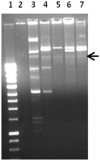Regional dissemination of a trimethoprim-resistance gene cassette via a successful transposable element
- PMID: 22666464
- PMCID: PMC3364232
- DOI: 10.1371/journal.pone.0038142
Regional dissemination of a trimethoprim-resistance gene cassette via a successful transposable element
Abstract
Background: Antimicrobial resistance is a growing international problem. We observed a 50% increase in the prevalence of trimethoprim resistance among fecal Escherichia coli from healthy Nigerian students between 1998 and 2005, a trend to increase that continued in 2009.
Methods and findings: A PCR-based screen revealed that 131 (43.1%) of isolates obtained in Nigeria in 2005 and 2009 carried integron-borne dfrA cassettes. In the case of 67 (51.1%) of these isolates, the cassette was a class 1-integron-borne dfrA7 gene, which has been reported at high prevalence from E. coli isolates from other parts of Africa. Complete sequencing of a 27 Kb dfrA7-bearing plasmid from one isolate located the dfrA7 gene within a Tn21-type transposon. The transposon also contained an IS26-derived bla/sul/str element, encoding resistance to β-lactams, sulphonamides and streptomycin, and mercury resistance genes. Although the plasmid backbone was only found in 12 (5.8%) of trimethoprim-resistant isolates, dfrA7 and other transposon-borne genes were detected in 14 (16.3%) and 32 (26.3%) of trimethoprim resistant isolates collected in Nigeria in 2005 and 2009, respectively. Additionally, 37 (19.3%) of trimethoprim-resistant E. coli isolates collected between 2006 and 2008 from Ghana were positive for the dfrA7 and a transposon marker, but only 4 (2.1%) harbored the plasmid backbone.
Conclusions: Our data point to transposition as a principal mechanism for disseminating dfrA7 among E. coli from Nigeria and Ghana. On-going intensive use of the affordable broad-spectrum antibacterials is likely to promote selective success of a highly prevalent transposable element in West Africa.
Conflict of interest statement
Figures




References
-
- Goldie SJ, Yazdanpanah Y, Losina E, Weinstein MC, Anglaret X, et al. Cost-Effectiveness of HIV Treatment in Resource-Poor Settings – The Case of Cote d’Ivoire. N Engl J Med. 2006;355:1141–1153. - PubMed
-
- Ford N, Mills E, Calmy A. Rationing Antiretroviral Therapy in Africa – Treating Too Few, Too Late. N Engl J Med. 2009;360:1808–1810. - PubMed
Publication types
MeSH terms
Substances
Grants and funding
LinkOut - more resources
Full Text Sources
Other Literature Sources
Medical

